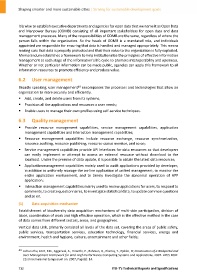Page 722 - Shaping smarter and more sustainable cities - Striving for sustainable development goals
P. 722
it is wise to establish executive departments and agencies for open data that we name it as Open Data
and Manpower Bureau (ODMB) consisting of all important stakeholders for open data and data
management processes. Many of the responsibilities of ODMB are the same, regardless of where the
person falls within the organization. So the heads of ODMB is a mandated role, and individuals
appointed are responsible for ensuring that data is handled and managed appropriately. This means
making sure that data is properly protected and that their value to the organization is fully exploited.
Memorandum establishes a framework to help institutionalize the principles of effective information
management at each stage of the information's life cycle to promote interoperability and openness.
Whether or not particular information can be made public, agencies can apply this framework to all
information resources to promote efficiency and produce value.
6.2 User management
49
Broadly speaking, user management encompasses the processes and technologies that allow an
organization to more securely and efficiently.
Add, create, and delete users from its systems;
Provision all the applications and resources a user needs;
Enable users to manage their own profiles using self‐service techniques.
6.3 Quality management
Provide resource management capabilities, service management capabilities, application
management capabilities and interaction management capabilities;
Resource management capabilities include resource exchange, resource synchronization,
resource auditing, resource publishing, resource status monitor, and so on;
Service management capabilities provide API interfaces for data resources so that developers
can easily implement or attempt to access an external resource without download to the
localhost. Under the premise of data update, it is possible to obtain the latest data resources;
Applicationmanagement capabilities mainly used to audit applications provided by developer,
in addition to uniformly manage the on‐line application of unified management, to monitor the
entire application environment, and to timely investigate the abnormal operation of APP
application;
Interaction management capabilities mainly used to review applications for users, to respond to
comments, to create questionnaires, to investigate statistical data, to update common questions
and so on.
(1) Data acquisition mechanism
Establishment of biodiversity data acquisition mechanisms of multi‐side participation, division of
labor, coordination of work and high effective operation, which is the effective method in the case
of data comes from different sectors, areas, and geographies.
Vertical data Link, primarily consistof all levels of the data set, covering the areas of public safety,
public services, transportation services, education technology, financial services, energy and
environment, health and hygiene, culture, entertainment and other fields;
____________________
49 Lichun Zhu, Kent, R.D., Aggarwal, A., Viranthi, P., Rahman, Q., Elamsy, T., Ejelike, O; Construction of a Webportal and
User Management Framework for Grid. High Performance Computing Systems and Applications, 2007. HPCS 2007.
21st International Symposium on. 2007, Page(s): 14.
712 ITU‐T's Technical Reports and Specifications

